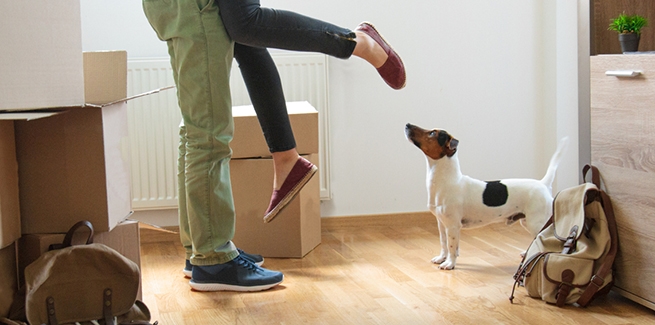On moving day, remember: Pets are family, not furniture

We’ve entered the peak moving season in the US. On average, more than 40 million people move each year in the United States, with an estimated 80% of those moves occurring between April and September.
And, according to an oft-quoted study on pet relinquishment at US animal shelters, the number one reason pet owners give for relinquishing pets is moving (7%). Due to logistical, financial, or other reasons, many pet owners thought trying to move a pet to a new home in a new location just wasn’t worth the hassle.
Does that mean we’ve also entered the peak season for pet relinquishment?
Not necessarily.
NEWStat reached out to Mo Salman, DVM, MPVM, PhD,professor of veterinary epidemiology at Colorado State University and lead author of that twenty-year old relinquishment study, to ask about the figures.
“Our study identified [moving] as a significant factor” in pet relinquishment, Salman said. But he pointed out that when his team conducted that study in the late 1990s, peoples’ attitudes toward their pets were different than they are today. Back then, Salman said, Americans “considered our pets as pieces of furniture instead of being members of the family.”
In other words, pets were largely seen as property—something you could leave behind if you had to.
These days, 85% of dog owners and 76% of cat owners consider their pets members of their families, according to a 2018 pet ownership survey by the American Veterinary Medical Association (AVMA). And that’s up from the AVMA’s 2012 ownership survey, when 63% said they considered their pets to be family members.
While there appear to have been no new studies that measure the number of pets given up for relinquishment due to reasons associated with moving, a new survey indicates that when today’s pet owners move, most are going above and beyond to make sure they don’t have to leave their pets behind.
- In January 2019, the moving company Mayflower Transit commissioned an online survey of pet owners. The survey had three primary objectives:To determine what home and neighborhood features are important to pet owners when moving
- To understand the steps people take to prepare their pet for a move to a new home
- To understand how pets adjust to a move and steps pet owners take to make the transition as smooth as possible
Respondents included 2,002 US cat and dog owners who have moved within the past five years or are likely to move within the next five years.
For pet owners who have moved in the past five years, 39% said they took the needs of their pets into consideration when choosing a house or apartment: Factors that influenced their decision included having adequate indoor space for the pet (56%), the size of the yard (46%) and neighborhood/landlord rules about pets (59%).
Additionally, 26% said owning pets influenced the choice of neighborhood, including such factors as the walkability of the community (42%), availability of pet-friendly recreational activities (27%), local pet-ownership laws regarding breed and size (43%), and proximity of a veterinary hospital (33%).
Planning ahead for pet care is important, and 23% found a veterinary hospital in their new community before moving. (The AAHA Hospital Locator can help with that.)
For pet owners who still aren’t sure about bringing their pets along next time they move, there’s this to consider: more than 9 in 10 owners say their pets adjusted to their new setting in less than a month.
And more than 90% of pet owners agreed that wherever they and their pets are together is instantly home.
Photo credit: © iStock/Milan_Jovic



